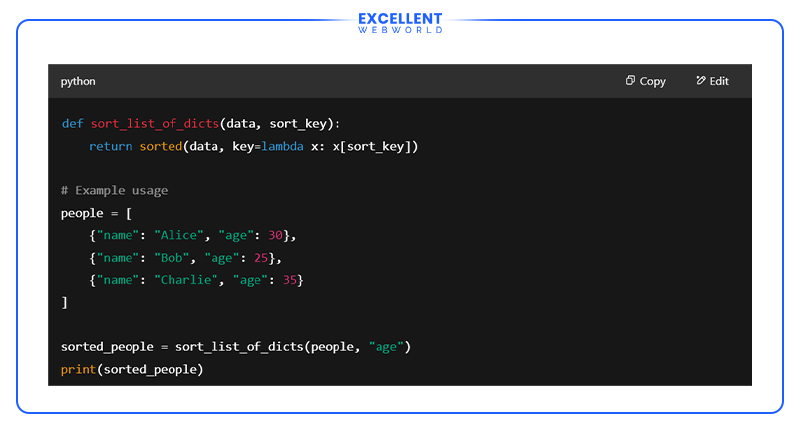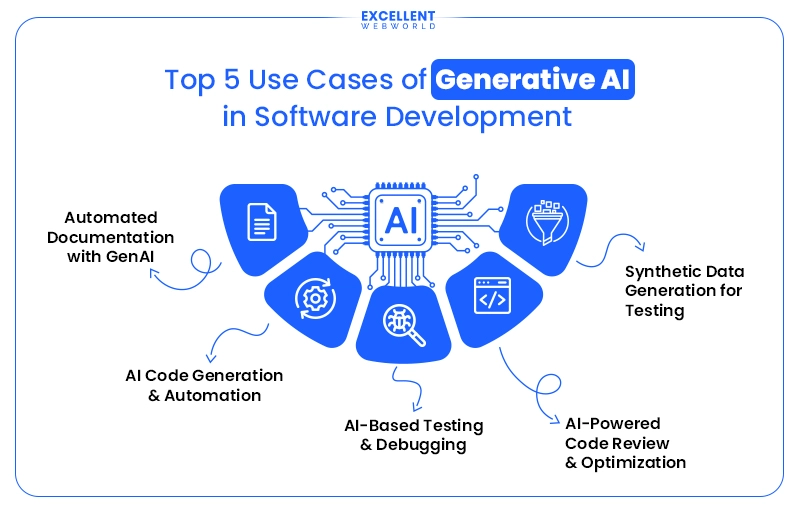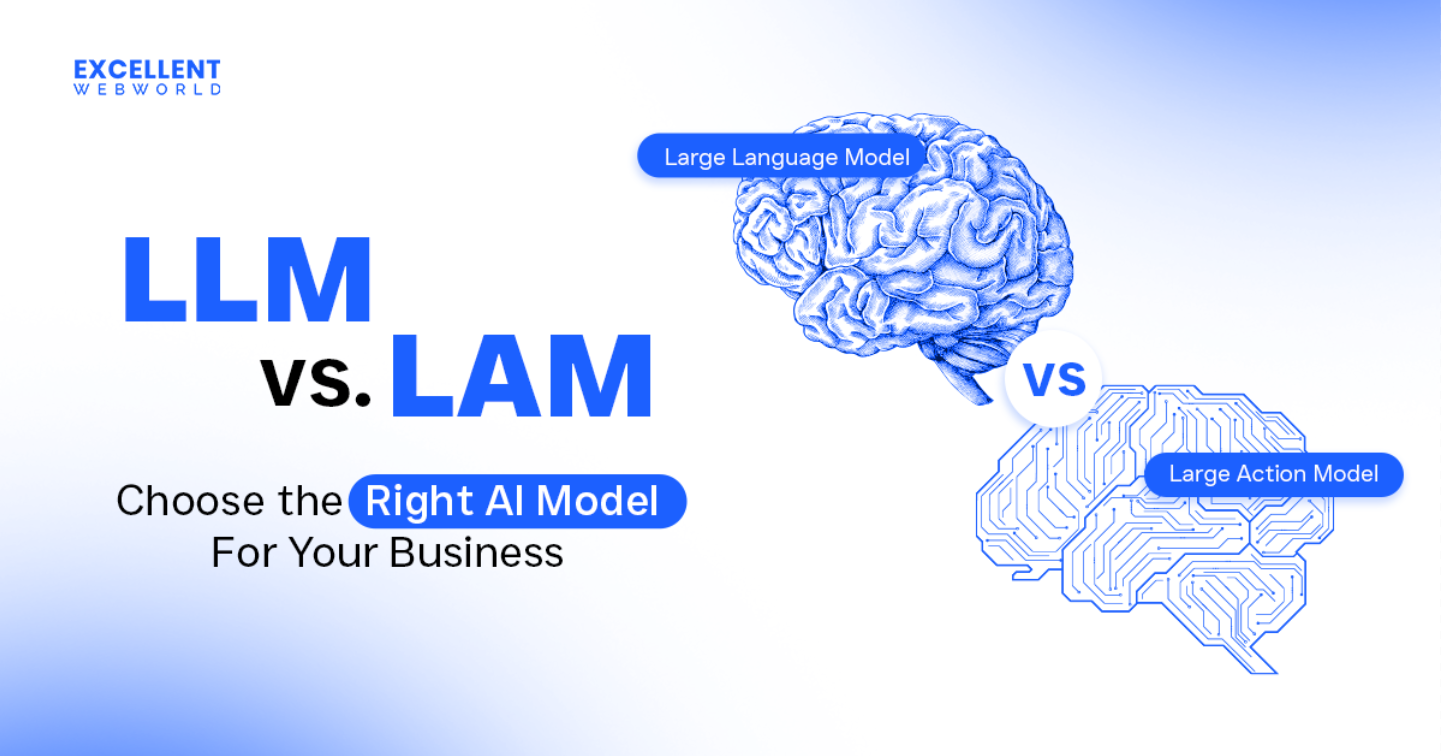With just a simple prompt on ChatGPT, “Write a function in Python to sort a list of dictionaries by a given key.”, you receive an immediate result, something like this:
You didn’t open your IDE. You didn’t scan old projects or search GitHub. You didn’t ask a teammate. Just scalable code, ready to go.
Prompt-based code generation like this is a perfect example of how AI integration in software development complements modern development practices and tools.
From a broad perspective, Generative AI in software development refers to the use of AI models to generate code, test cases, documentation, and design components by analyzing existing data patterns and user prompts.
Whether it’s about writing functions or explaining code logic, GenAI tools are transforming how developers work. This LLM-based system is not a substitute for developers, but a co-pilot that manages routine tasks so engineers can focus on real development challenges.
Let’s figure out the best generative AI use cases in software development.
Use Cases of Generative AI in Software Development
In software development, generative AI is used to generate code, suggest optimizations, create documentation or API references, and automate tasks like testing and UI design. Such capabilities help the team to accelerate coding and maintain quality throughout the software development process.
Even GitHub’s developer survey highlights that 92% of developers have used AI coding tools, either for work purposes or for personal use, and 70% believe these tools give them an edge, with upskilling and productivity being the top advantages. Let’s look at the different ways in which generative AI helps improve software development.
1. AI Code Generation and Automated Coding Tools
AI-powered code generation tools convert natural language prompts or partial code snippets into functional code compatible with leading mobile programming languages, web programming languages, and widely used software development frameworks. Such an approach cuts down the time spent on boilerplate or repetitive coding. Here are some of the tools that help in GenAI code generation.
The adoption of GenAI for coding helps maintain coding standards and reduce human error, which makes it one of the best generative AI use cases in software development. Also, it frees developers to focus on more complex architectural decisions or supporting tasks like project documentation or content creation.
2. AI-Driven Software Testing and Debugging
Across the software development lifecycle, testing and debugging require teams to spend hours chasing issues and writing exhausting test scenarios. Instead of manually writing test cases or scanning bugs line by line, generative AI for developers helps recognize coding patterns and automate many of their routine tasks.
GenAI models understand how user interacts with the applications in real scenarios. It then uses the understanding to develop realistic test paths and detect flaws that manual testers overlook. When added to CI/CD pipelines, these models evaluate code updates consistently and raise meaningful suggestions based on the intent and behavior of the code.
3. AI-Assisted Code Review and Performance Optimization
Code reviews are important for maintaining quality, but these review slows down workflows due to manual effort and differing opinions. Here, GenAI tools assist in automating a few parts of this process by detecting redundant logic, flagging bugs, and suggesting better code structure.
Instead of replacing human reviewers, these GenAI tools for software development act as a second pair of eyes. They just point out inefficient code and suggest simplifications, which helps speed up and sharpen peer reviews. Let’s say you are working on integrating AI in mobile app development, handling large codebases, or distributed teams. In that case, these tools ensure better code quality without delaying sprints.
Performance tuning is also an area where GenAI contributes. AI tools are excellent at studying how code executes and uses memory to offer recommendations like restructuring queries or loop improvements. This is particularly valuable for an AI native app that comprises both generative and traditional apps with heavy traffic, where small changes result in noticeable gains.
4. Automated Technical Documentation with GenAI Models
Instead of sticking to manual documentation tasks, developers rely on generative AI models to translate active code into useful summaries and descriptions during code development.
These models excel at analyzing method structure, variable usage, and function intent. It generates exact documentation that aligns with the developer’s perspective without interrupting the coding process.
For example, when a developer builds or revises API and backend services, GenAI thoroughly monitors them and generates documentation. It outlines the summaries, parameter breakdowns, and usage recommendations. Such capabilities reduce the time to create documentation and ensure it contains technical content that is aligned with production logic.
This is particularly valuable for microservices and fast-release cycles, where keeping documentation up to date with manual efforts gets overlooked.
5. Synthetic Data Generation for Testing and Privacy
Producing authentic datasets that protect user privacy is still a challenge in software development. How does GenAI address it? By learning patterns from the real data and producing synthetic datasets that replicate those patterns without exposing sensitive data. Here is how GenAI supports synthetic data generation.
This approach allows developers and testers to validate application behavior within different scenarios. It also helps simulate edge cases that are rare or difficult to capture in production data.
The above generative AI use cases in software development cover routine tasks. But do you know which are the advanced use cases for generative AI? Let’s check out advanced GenAI applications in software development.
Advanced GenAI Applications in Software Development Workflows
Let’s discuss how generative AI contributes to different areas of software development, like design, developer experience, and codebase modernization.
6. AI-Driven Automated UI/UX Wireframing and Prototyping
Software development and design are no longer separate phases but work side by side. Imagine a product team sharing a feature requirement in simple terms during a morning briefing. Moments later, AI converts that description into a usable wireframe that outlines layouts and UI components. Then, designers polish visuals and user interactions. This approach will speed up the transition from concept to prototype.
The process will transform prototyping from time-consuming iterations to an AI-assisted workflow. You will see faster concept trials, prompt usability feedback, and focused design efforts as key advantages to this method.
7. Conversational AI and Coding Assistants for Developer Support
Developers today rely on coding assistant tools like GitHub Copilot and Tabnine to get required assistance with routine coding tasks. No doubt, these tools produce boilerplate code but lack to understand the full project logic and engineering goals.
This makes it possible that the next wave of developer support will include AI capable of intelligent conversions, predictive analysis, and project-aware collaboration. Many businesses will even hire developers experts in ChatGPT or similar AI tools to fully leverage these capabilities.
Check out some future capabilities that GenAI will offer in terms of dev support.
The objective here is to transform from passive tools to active co-developers that contribute to the architectural choices and integration flow.
8. Personalized AI Training and Onboarding for Engineering Teams
The basic approach of developer onboarding includes static documents and time-consuming sessions, which slow down the ramp-up time and lead to incomplete knowledge transfer. AI-driven onboarding will cut this time, helping reduce your software development cost per hire. Firms will use GenAI to build contextual training tailored to developers’ roles, project scope, and tech stack.
For example, a frontend engineer working on a React app can prompt an internal generative AI tool to explain specific component structures and design patterns, even recent pull requests relevant to their tasks. It changes how technical onboarding is scaled within teams.
Real-time support from GenAI helps developers understand not just the “how” but the “why” behind the code. Over time, it supports experienced senior developers while keeping new hires productive from day one.
9. AI-Powered Legacy Code Modernization
Legacy codebases pose difficulties for modernization. This is due to their old code frameworks and limited documentation. In traditional software development services, current practices of developers involves manual interventions that increases the chances of bugs and requires considerable time to protect system stability during upgrades.
Generative AI will reshape the approach by reviewing the legacy systems, spotting deprecated codes, and proposing efficient modern solutions. Also, it will excel at automated documentation generation and guide modernization efforts to improve maintainability. In this case, developers will achieve better performance and easier transitions without the requirement of a complete codebase replacement.
The rise of generative AI use cases in software development shows how rapidly AI is advancing in this field. However, without proper software development consulting to guide execution, teams risk facing issues that stall adoption and limit the benefits of generative AI in software development. Let’s review the challenges faced while implementing GenAI.
Generative AI Implementation Challenges and How to Avoid Them
Let’s accept it; generative AI offers promising improvements in software development, but integrating it comes with a set of challenges. We have covered these generative ai challenges in-depth. Rushing into adoption without a clear strategy often results in setbacks or wasted resources. Many teams fall into common mistakes in gen AI development, such as misaligned use cases or poor validation, which can derail even well-funded projects.
Many teams face these challenges when adopting generative AI without a defined strategy. Reliable AI consulting services or AI development services help businesses choose the right models and build efficient workflows. This approach ensures solutions are accurate and scalable for product development.
Maximize the ROI of Generative AI in Software Engineering
Now, you know how to speed up software development using generative AI technology. However, to get the best benefits, businesses need a strategic approach that aligns AI with their goals and workflows. This is crucial for leveraging the full benefits of custom software development. Let’s explore some of the services we offer to help you effectively use generative AI.
If you want to maximize the impact of generative AI on your software project, reach out to us. Our experts will help you build scalable GenAI solutions.
FAQs About Generative AI for Software Development
The role of Generative AI in software development includes various capabilities from automating repetitive coding to producing technical documentation. Developers are able to dedicate time to problem-solving and design while AI manages the repetitive tasks. It functions as a helpful partner who is contributing to accelerating project timelines and improving code quality.
Here is the entire process of how you can implement GenAI into your development workflow.
Here are the benefits that software development teams receive from generative AI.

Article By
Mahil Jasani began his career as a developer and progressed to become the COO of Excellent Webworld. He uses his technical experience to tackle any challenge that arises in any department, be it development, management, operations, or finance.





